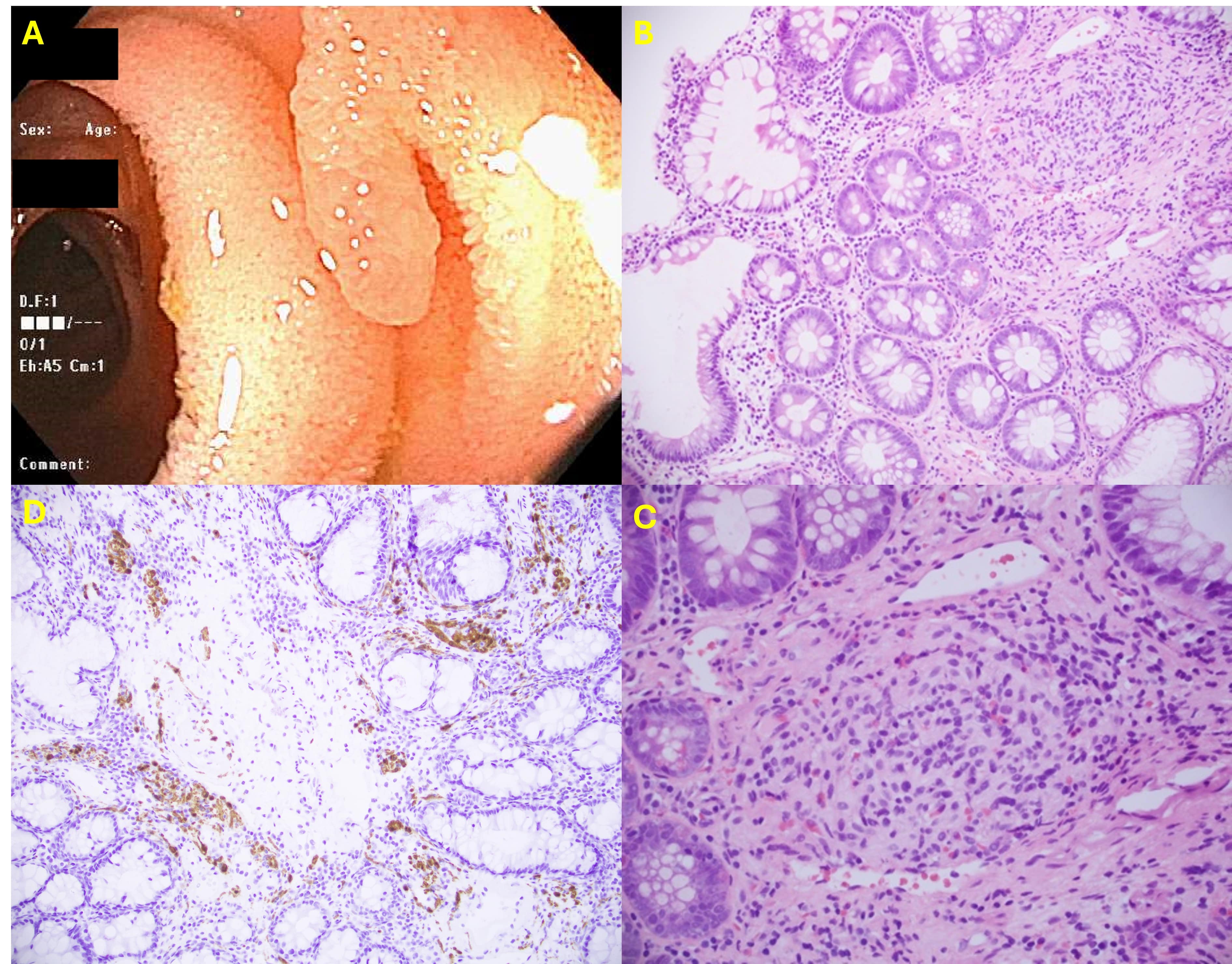Sunday Poster Session
Category: Small Intestine
P1581 - A Rare Ileal Lesion: First Report of Mucosal Schwann Cell Hamartoma in the Small Intestine
Sunday, October 27, 2024
3:30 PM - 7:00 PM ET
Location: Exhibit Hall E

Has Audio

Ambar Godoy Rivas, MD
Indiana University
Indianapolis, Indiana
Presenting Author(s)
Azizullah Beran, MD1, Ambar Goday Rivas, MD2, Robert E.. Emerson, MD2, Umer Bhatti, MD1
1Indiana University School of Medicine, Indianapolis, IN; 2Indiana University, Indianapolis, IN
Introduction: Mucosal Schwann cell hamartomas (MSCH) are rare, benign neurogenic tumors composed of Schwan cells. They are usually found in the colon and less frequently in the stomach and are often asymptomatic, discovered incidentally during endoscopic examinations. In this report, we describe a case of MSCH discovered in the ileum.
Case Description/Methods: A 44-year-old female undergoing a colonoscopy for surveillance and chronic diarrhea had a 5-mm tubular polypoid lesion identified in the terminal ileum, resected with a cold snare (Figure 1A). Microscopic examination revealed a proliferation of spindle cells with elongated nuclei and eosinophilic cytoplasm arranged in a disorganized pattern within the mucosa (Figures 1B and 1C). Immunohistochemical staining showed strong positivity for S-100 protein, confirming the diagnosis of MSCH (Figure 1D). The terminal ileum was otherwise normal to 10 cm. Additionally, five polyps, ranging from 3 to 13 mm, were found in the cecum, ascending colon, transverse colon, and sigmoid colon, removed by cold snare. Pathological examination of these polyps revealed hyperplastic polyps and tubular adenomas, which were negative for dysplasia. Random biopsies from the colon showed no significant abnormalities. A repeat colonoscopy was recommended in three years due to multiple adenomatous polyps, and the MSCH was noted as a benign incidental finding. Follow-up was advised for diarrhea.
Discussion: To our knowledge, this is the first reported case of MSCH located in the small intestine. This case highlights the unique occurrence of a Schwann cell hamartoma in the terminal ileum, a location not previously reported in medical literature. Schwann cell hamartomas are most commonly found in the colon and are rarely in the stomach. The discovery of this lesion in the terminal ileum expands the known anatomical distribution of these tumors. It underscores the importance of considering Schwann cell hamartomas in the differential diagnosis of ileal lesions. Other polypoid lesions described in the colon, such as neuroendocrine tumors, gastrointestinal stromal tumors, schwannomas, neurofibromas, ganglioneuromas, and granular cell tumors, can all be differentiated with histopathological evaluation from Schwann cell hamartomas, mainly due to their strong S100 stain positivity. Further studies are needed to explore the clinical significance and potential implications of MSCHs in this location.

Disclosures:
Azizullah Beran, MD1, Ambar Goday Rivas, MD2, Robert E.. Emerson, MD2, Umer Bhatti, MD1. P1581 - A Rare Ileal Lesion: First Report of Mucosal Schwann Cell Hamartoma in the Small Intestine, ACG 2024 Annual Scientific Meeting Abstracts. Philadelphia, PA: American College of Gastroenterology.
1Indiana University School of Medicine, Indianapolis, IN; 2Indiana University, Indianapolis, IN
Introduction: Mucosal Schwann cell hamartomas (MSCH) are rare, benign neurogenic tumors composed of Schwan cells. They are usually found in the colon and less frequently in the stomach and are often asymptomatic, discovered incidentally during endoscopic examinations. In this report, we describe a case of MSCH discovered in the ileum.
Case Description/Methods: A 44-year-old female undergoing a colonoscopy for surveillance and chronic diarrhea had a 5-mm tubular polypoid lesion identified in the terminal ileum, resected with a cold snare (Figure 1A). Microscopic examination revealed a proliferation of spindle cells with elongated nuclei and eosinophilic cytoplasm arranged in a disorganized pattern within the mucosa (Figures 1B and 1C). Immunohistochemical staining showed strong positivity for S-100 protein, confirming the diagnosis of MSCH (Figure 1D). The terminal ileum was otherwise normal to 10 cm. Additionally, five polyps, ranging from 3 to 13 mm, were found in the cecum, ascending colon, transverse colon, and sigmoid colon, removed by cold snare. Pathological examination of these polyps revealed hyperplastic polyps and tubular adenomas, which were negative for dysplasia. Random biopsies from the colon showed no significant abnormalities. A repeat colonoscopy was recommended in three years due to multiple adenomatous polyps, and the MSCH was noted as a benign incidental finding. Follow-up was advised for diarrhea.
Discussion: To our knowledge, this is the first reported case of MSCH located in the small intestine. This case highlights the unique occurrence of a Schwann cell hamartoma in the terminal ileum, a location not previously reported in medical literature. Schwann cell hamartomas are most commonly found in the colon and are rarely in the stomach. The discovery of this lesion in the terminal ileum expands the known anatomical distribution of these tumors. It underscores the importance of considering Schwann cell hamartomas in the differential diagnosis of ileal lesions. Other polypoid lesions described in the colon, such as neuroendocrine tumors, gastrointestinal stromal tumors, schwannomas, neurofibromas, ganglioneuromas, and granular cell tumors, can all be differentiated with histopathological evaluation from Schwann cell hamartomas, mainly due to their strong S100 stain positivity. Further studies are needed to explore the clinical significance and potential implications of MSCHs in this location.

Figure: Figure 1
Disclosures:
Azizullah Beran indicated no relevant financial relationships.
Ambar Goday Rivas indicated no relevant financial relationships.
Robert Emerson indicated no relevant financial relationships.
Umer Bhatti indicated no relevant financial relationships.
Azizullah Beran, MD1, Ambar Goday Rivas, MD2, Robert E.. Emerson, MD2, Umer Bhatti, MD1. P1581 - A Rare Ileal Lesion: First Report of Mucosal Schwann Cell Hamartoma in the Small Intestine, ACG 2024 Annual Scientific Meeting Abstracts. Philadelphia, PA: American College of Gastroenterology.
